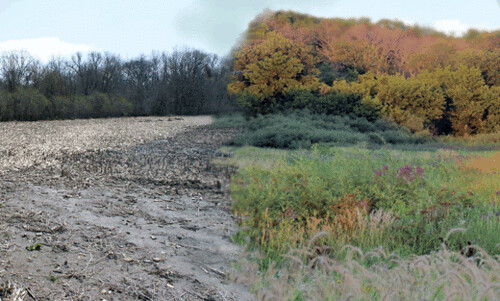
If the land floods more often than growing a crop, why not let it go back to what it wants to be – a wetland. That’s what happened on the Hoppe Heritage Farmstead in 2011. The Hoppe sisters owned cropland along the southern branch of the Kishwaukee River in DeKalb County, Ill. About half of the land would flood on a regular basis.
After several years of dealing with the floods, the sisters decided to do something about it. They sold the homestead to the DeKalb County Forest Preserve District, which preserves and restores landscapes and their plant and animal life.
Terry Hannan, the forest preserve’s superintendent, contacted USDA’s Natural Resources Conservation Service about a conservation easement as a possible opportunity to improve the land.
NRCS provides technical and financial assistance for wetland restoration projects like this one. The Hoppe sisters enrolled 55 acres land into the former Wetlands Reserve Program. The 2014 Farm Bill replaced that program with the Agricultural Conservation Easement Program, which has similar goals.
“This was a three way deal,” said Paul Searl, a district conservationist with NRCS. “We bought the easement from the sisters, and then they sold the land to the forest preserve. We started the process in early 2008.”
Before re-establishing the native plants, extensive research was done to ensure plant were accurate to pre-settlement conditions. Al Roloff, the forest preserve’s natural resources manager, used several reference books as well as records and observations of plant species that exist in local remnant plant communities.
NRCS provided six-inch topographic measurements that made planting much easier. The map gives elevations of the land, enabling Roloff to select the proper plants for the soil type. The lowest elevation, because of the standing water, was planted with root divisions, mud clumps and plugs.
Later, when the area dried, he and volunteers scattered seeds by hand of bulrushes, other sedges and forbs. Roloff was excited by the rapid results of their restoration work. “The first year germination rates far surpassed my expectations,” he said.
The main threat is the canary reed grass and some cattails, both invasive plants. “The main focus was the vegetation with a concern of invasive species,” Searl said.
The tile that originally drained the field was brought to the surface with a riser. Now, instead of water leaving the fields through this drainage system, it holds water on the fields, helping in its transformation to a wetland.
After just two growing seasons, the plantings have taken hold dramatically. “The diversity and density of plants has been amazing,” Roloff said. Including the prairie buffer, there are more than 100 different species located in this 55 acre plot.
From 2010 to 2012, a study was conducted on the mussel populations in the Kishwaukee River in DeKalb County, including the stretch of river that runs through South Branch Prairie and the connecting Russell Woods Preserve.
Mussels are indicators of water quality because their survival rate is lowered when covered with sediment and pollutants. Wetlands improve water quality by filtering nutrients, pollutants and sediment and lead to other environmental benefits, including creating better habitat for mussels.
“They found 14 species of mussels in large numbers, much large than anywhere else in the river,” Roloff said. “It is the most rich and diverse portion of the Kishwaukee River.”
Roloff said these discoveries help highlight the important of wetlands on water quality.
Through NRCS conservation easements, South Branch Prairie, added to the corridor of other existing forest preserves, wildlife has flourished with sightings of bald eagles, sandhill cranes and many different shorebirds. Diversity in plants benefits pollinators, protects the soil and improves water quality.
“With the forest preserve and wetland collecting water runoff and filtering it before entering the river,” the water quality in this stretch of the river is the best in northern Illinois,” Searl said.

